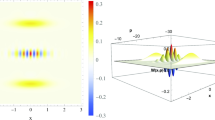Abstract
The overlap factors for bond electrons in various diatomic halides are calculated making use of a simple relation where the overlap factor is an inverse exponential function of the difference between the two atomic radii of the molecule concerned. These overlap factors together with the hybridization values of 15 percent for Cl, and 10 percent for Br and I are used to calculate the ionic characters for various diatomic molecules from the values of the nuclear quadrupole coupling constants obtained by earlier workers. These ionic characters are then plotted against electronegativity differences and the points are found to be fairly well represented by a smooth curve. It is shown that this curve can in general be used for the determination of the ionic characters in the halogen containing single bonds of certain polyatomic molecules. The quadrupole coupling constants are calculated from the ionic characters obtained from the curve and are compared with those observed. The effects of the distortion of the closed shells and of the neighbouring ions oneQq are discussed.
Similar content being viewed by others
References
Gordy, Smith and TrambaruloMicrowave Spectroscopy, John Wiley & Sons, Inc., 1953.
Townes, C. H. and Schawlow, A.Ibid., McGraw-Hill Co., Inc., 1955.
Dailey, B. P. and Towness, C.H.J. Chem. Phys., 1955,23, 118.
Jaccarino, King and Stroke —.
Townes, C. H. and Dailey, B.P.J. Chem. Phys., 1949,17, 782.
Gordy, W.J. Chem. Phys., 1951,19, 792.
-Faraday Society Discussion (Microwave and Radio-frequency Spectroscopy), April 1955. (The authors wish to express their thanks to Professor Walter Gordy for sending a manuscript copy of his discussion.)
Pauling, L.Nature of Chemical Bond, Cornell University Press, Ithaca, 1948, p. 76.
Slater, J. C.Phys. Rev. 1930,36, 57.
Mulliken, Reike, Orloff and OrloffJ. Chem. Phys., 1949,17, 1248.
Honig, Mandel, Stitch and TownesPhys. Rev., 1954,96, 629.
Paul N. SchaltzJ. Chem. Phys., 1954,22, 755.
Huggins, M. J.J. Am. Chem. Soc., 1953,75, 4123.
Townes, C. H. and Dailey, B.P.J. Chem. Phys., 1952,20, 35.
Sheridan, J. and Gordy, W. —, 1951,19, 965.
Mays, J. M. and Dailey, B.P. —, 1952,20, 1695.
Author information
Authors and Affiliations
Additional information
Communicated by Dr. R. K. Asundi,f.a.sc.
The authors wish to express their thanks to Dr. A. N. Mitra for helful discussion and to Professor P. S. Gill for his kind interest in the work.
Rights and permissions
About this article
Cite this article
Venkateswarlu, P., Jaseja, T.S. The ionic character of singly bonded molecules. Proc. Indian Acad. Sci. 44, 72–82 (1956). https://doi.org/10.1007/BF03048804
Received:
Issue Date:
DOI: https://doi.org/10.1007/BF03048804




